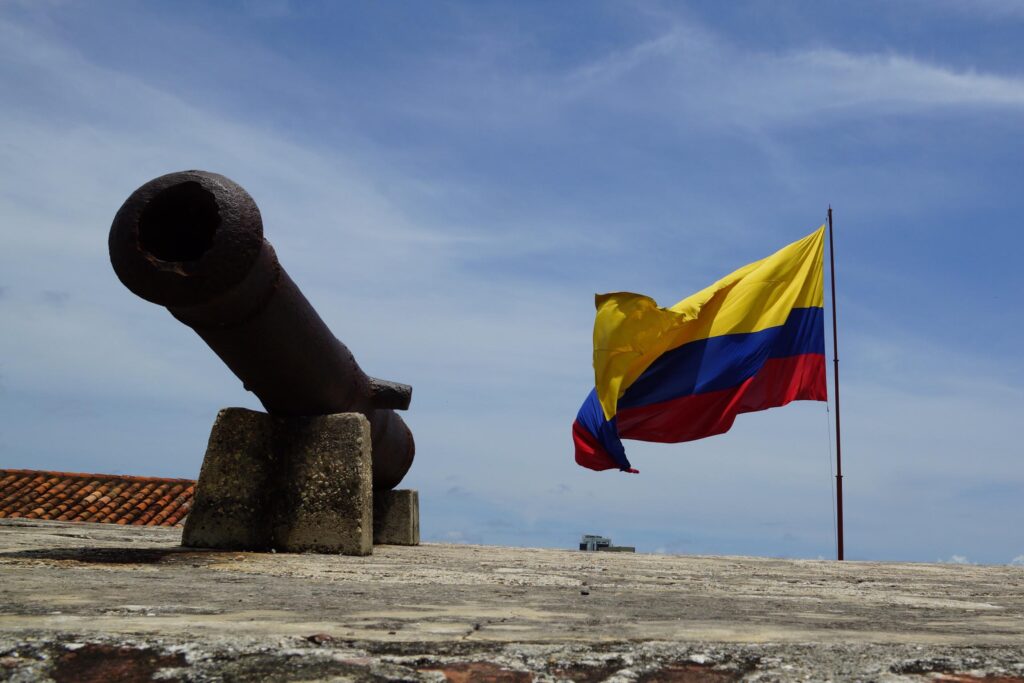20th of May
A fairy-tale city of history, legends and sheer beauty, Cartagena de Indias is the most beautiful city in Colombia, with cobbled alleys, enormous balconies shrouded in bougain-villea and massive churches casting their shadows across leafy plazas.
Peter picks us up at the hotel and soon we are in the air heading for South America. Cartagena is our destination there and memories of „Romancing the Stone“ are coming back. Our trip is not so spectacular and the handling at Cartagena International Airport is very effective. It is only a short 15 minutes ride into town and the hotel „Casa Pestagua“ is very nice. The house was built at the beginning of the seventeenth century and changed hands several time until the current owner turned it into a hotel.
A short lunch in one of the outdoor restaurants in Plaza Santa Domingo turns out into a longer wait. Since the afternoon is still pretty young, we decide to take 4 bicycles from the hotel and explore the city on our own. First we ride on the old city wall but then turn into the old town. This is the main attraction with the historical districts of El Centro and San Diego. We love the many beautiful squares and flower-bedecked balconies. Almost every street is a postcard-worthy scene of 16th and 17th century architecture.
After a while we run into a large cheering crowd near the Las Murallas. We check it out and there is a Baseball tournament for girls going on. The only white girl in one of the teams, La Gringa“, explains us that this is a pretty rough neighborhood and with this project the try to work with the people. Well, everybody is having fun and after a while we decide to become supporter for the white team. tar
Back at the hotel, we hit the pool for a swim and take advantage of the complimentary foot massage. For dinner, we decide to go for Pizza – something we know and did not have for quite a while.
21st of May
The Spaniards made Cartagena an impregnable port and constructed elaborate walls encircling the town, and a chain of forts. These fortifications helped save Cartagena from pirate attacks and several sieges.
After a local breakfast, actually quite nice, we get picked up by Edi, our 69-year old tour guide and a driver. The first stop is in one of the poorer neighborhoods; the one Edi lived first when he moved to Cartagena from the jungle region in the mountains. A lot of people are happy to see him, greet him cheerfully and from some of the ladies he gets a romantic „mio amor“.
We visit forts, churches, walk through nice streets – and it is getting hotter! A steep roads, leading through some not so pretty slums, brings us up to the Convento de la Popa. Situated on a 150 meter high hill, it offers a very nice view. Edi talks like a book and gives us all the explanations. A healthy and mentally fit elderly gentleman.
The highlight of the tour was the Castillo de San Felipe de Barrajas. Construction of this huge stone fortress begun in 1639 but was not completed until some 150 years later. Ten-thousands of slaves brought in from Africa worked on it. Their survival rate was not too high. There are 2.6 kilometers of tunnels built to facilitate the supply and evacuation of the fort.
Cartagena was founded in 1533 and became the treasure city of the Spanish Main, where precious stones and minerals plundered from the indigenous people awaited transshipment to Spain. Although the harbor was guarded by 29 stone forts and the city was encircled by a high wall of coral, Cartagena suffered sackings and invasions — in 1544, 1560, and in 1586 (by Sir Francis Drake). In 1741 it withstood a three-month British siege. The city was the first of those in Colombia and Venezuela to declare (1811) absolute independence from Spain. Known as the Republic of Cartagena, it was one of the bases used by Simón Bolívar to launch his campaign to liberate Venezuela. In 1815 the city was besieged and captured by the Spanish general Pablo Morillo, who inflicted savage reprisals on the population. Captured by rebel forces in 1821, Cartagena was incorporated into Colombia.
Today Cartagena has expanded dramatically and is surrounded by vast suburbs. It is Colombia‘s largest port and important industrial center of 1.1 million. Nevertheless the old walled town has changed very little.
After this exhausting three hours with Edi, we decide to relax at the pool, pilots preparing the flight for tomorrow to Cuba and the webmaster worked for 3 hours on his photos. He went slightly over the top in beautiful Cartagena.
